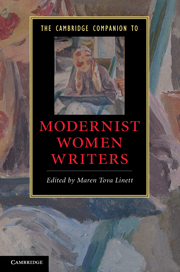Book contents
- Frontmatter
- Modernist women’s literature: an introduction
- 1 Transforming the novel
- 2 Modernist women poets and the problem of form
- 3 Women’s modernism and performance
- 4 Magazines, presses, and salons in women’s modernism
- 5 Gender in women’s modernism
- 6 Black women’s modernist literature
- 7 Race and ethnicity in white women’s modernist literature
- 8 Geomodernism, postcoloniality, and women’s writing
- 9 Women modernists and visual culture
- 10 Modernism and trauma
- 11 Political activism and women’s modernism
- 12 Religion and the occult in women’s modernism
- Guide to further reading
- Index
7 - Race and ethnicity in white women’s modernist literature
Published online by Cambridge University Press: 28 November 2010
- Frontmatter
- Modernist women’s literature: an introduction
- 1 Transforming the novel
- 2 Modernist women poets and the problem of form
- 3 Women’s modernism and performance
- 4 Magazines, presses, and salons in women’s modernism
- 5 Gender in women’s modernism
- 6 Black women’s modernist literature
- 7 Race and ethnicity in white women’s modernist literature
- 8 Geomodernism, postcoloniality, and women’s writing
- 9 Women modernists and visual culture
- 10 Modernism and trauma
- 11 Political activism and women’s modernism
- 12 Religion and the occult in women’s modernism
- Guide to further reading
- Index
Summary
“The contemplation of this black presence is central to any understanding of our national literature and should not be permitted to hover at the margins of the literary imagination.” / As Toni Morrison and postcolonial critics have argued, the “black presence” in America, the Jewish presence in Europe, and colonialism and empire in Britain, are central to the literary imagination of Anglo-American modernism, “are indeed constitutive of it.” If modernism, broadly defined, involves a critical relation to “Modernity,” as Enlightenment, reason, and progress, it also calls into question any simple essentialist view of identity. Racial, religious, and ethnic differences (as defined by the racialized discourses of the period 1900-40) are thus used to represent the divisions of the modernist subject. White women's modernist writing suggests different degrees of ambivalence, complicity, and opposition to the dominant discourses on race and ethnicity. All the terms of this chapter's title deserve discussion and invite reflection, often needing to be understood in relation to plural others rather than as halves of binary opposites. For although nationality is a political category, race a genetic, and ethnicity a cultural category, for modernist writing the meanings of “race” and “ethnicity” are historically shifting and often overlapping, shaped by nineteenth-century eugenicist and social Darwinian theories and by the historical and political events of the period. In what follows, the term “modernist” is understood in an inclusive sense. Edward Said claims that Conrad, Forster, and others took narrative form from “the triumphalist experience of imperialism,” creating discontinuity, self-referentiality, and a corrosive irony “whose formal patterns we have come to recognise as the hallmarks of modernist culture.”
- Type
- Chapter
- Information
- The Cambridge Companion to Modernist Women Writers , pp. 110 - 128Publisher: Cambridge University PressPrint publication year: 2010



